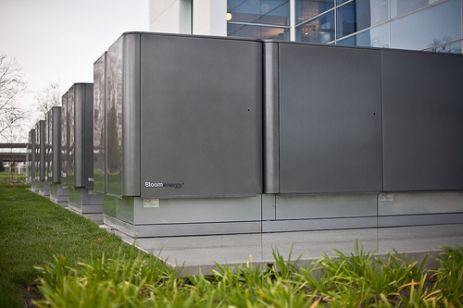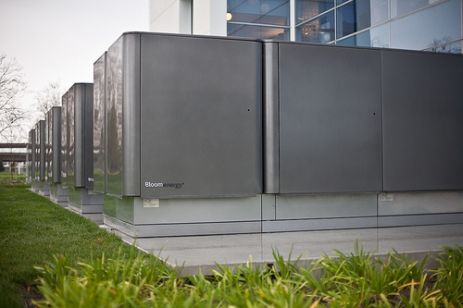 Bloom Energy at the eBay headquaters. Photo courtesy BloomEnergy via Flickr
Bloom Energy at the eBay headquaters. Photo courtesy BloomEnergy via Flickr
Cross-posted from WattHead.
With all the hype today around the release of the “breakthrough” Bloom Energy fuel cell (which has become known as the “Bloom box” and is referred to by Bloom as an “Energy Server“), it’s good to find a couple of posts looking at some real details:
Todd Woody, writing for the NYTimes GreenInc blog, has some details on the design of the Bloom Box solid oxide fuel cells from his look inside the Bloom Energy facilities this week. And Lux Research has this post looking at the economics of the Bloom Box, which is a good read.
It appears that the unsubsidized price of the Bloom Box is about $7-8,000/kW so their 100 kW units cost $700,000-800,000 without subsidy. As a fuel cell, it also needs fuel to run, in this case natural gas or another source of methane (such as landfill gas or biogas from anaerobic digesters).
After federal subsidies for fuel cells (they can claim the same 30 percent investment tax credit that solar gets) and a $2,500 California rebate, and assuming $7/mmBTU price for natural gas, a 100 kW Bloom Box unit generates electricity at 8-10 cents/kWh. That compares favorable to commercial electricity rates in many parts of the country, (average about 11 cents/kWh across U.S. with higher rates in several states, including California, New York, and Hawaii) so there could be good market for the Bloom Box in distributed generation applications in a variety of places, assuming federal/state subsidies holds out.
Unsubsidized cost would be 13-14 cents/kWh, with about 9 cents/kWh from the capital costs of the Bloom box and 5 cents/kWh from natural gas costs, according to Luz Research. If natural gas prices rise or fall 50 percent (gas prices are often volatile), overall price would fluctuate from 11.5-12.5 cents/kWh to 20.5-21.5 cents/kWh. That unsubsidized price is still too high to compete in most markets with retail electricity without subsidy. However, this is the first generation, and if Bloom can bring prices down (and/or natural gas prices are stable/low), there could be a significant market for this fuel cell.
As far as climate benefits, supposedly it generates electricity at 50-55 percent conversion efficiency. CO2 emissions when running on natural gas would be just under 0.8 pounds/kWh, which compares favorably to electricity from central station coal-fired plants (2 lbs/kWh) or natural gas plants (roughly 1.3 lbs/kWh) and the national average for on-grid electricity (around 1.3-1.5 lbs/kWh). Clearly, though the Bloom Box is still not a zero emissions tech and would only cut emissions by roughly 50 percent relative to the national average, unless it runs on landfill gas or biogas or hydrogen from electrolysis fueled by zero-carbon electricity (which would be much more expensive as you have to add cost of electrolysis unit, higher cost electricity, and about 30 percent conversion losses in electrolysis).
It is also worth noting that the average emissions rate of grid electricity in some states is less than the Bloom Box’s 0.8 lbs/kWh. According to EPA’s eGrid database, that list of states includes Vermont, Idaho, Washington, Oregon, California and New Jersey. However, EPA does not account for imported electricity across state borders, which tends to increase the emissions rates of most of these states. California, for example, has an emissions rate of about 0.65 lbs/KWh according to eGrid — which is notably less than the Bloom Box’s emissions rate running on natural gas — but more like 1.0 lbs/KWh when imports of mostly-coal-fired electricity from out of state is factored in (author’s calculations). When imports are factored in, this author calculates that average emissions rates for on-grid electricity in Vermont, Washington, and Oregon still fall below that of the Bloom fuel cell (but emissions rates vary within each state from utility to utility as well).
Solid oxide fuel cells have notoriously faced challenges with durability, since they operate at very high temperatures, which the Bloom box will also have to overcome to prove profitable. Todd Woddy writes:
In seven months of [pilot test] operations, Bloom has replaced a few fuel-cell wafers, but the machines have otherwise operated without a problem, Ms. Skoczlas Cole [of Ebay] said.
Bloom executives said the company spent years developing a proprietary seal made from low-cost materials to prevent cracks and leaks. They estimate that the Bloom boxes will have a 10-year lifespan and that the company will have to swap out the fuel-cell stacks twice during that time.
Mike Brown, an executive with UTC Power, a leading fuel-cell maker, said the fuel cells need to last at least four or five years for the technology to be competitive.
The advantage of solid oxide fuel cells running so hot is that all that waste heat can potentially be put to good use. When co-generating heat and electricity, solid oxide fuel cells can reach combined efficiencies upwards of 85 percent, which is excellent, but no word yet whether or not the Bloom fuel cell will co-generate heat. At this point, it appears that it does not (particularly given it’s use to power data centers and the like, which can’t put the heat to very good use; cooling is more of an issue for data centers!). That’s a shame, but perhaps another model of the product at some point in the future will be suited to co-generation applications (e.g. to provide process heat to industrial facilities or neighborhood district heating schemes). [Update: commenter Amazingdrx at Grist reminds me that waste heat can indeed be used to provide cooling using the common absorption refrigeration technique (which I should have recalled, since the entire campus at my alma mater, the University of Oregon – Go Ducks! – was cooled using absorption chillers run by our natural gas plant). So the waste heat from these fuel cell stacks should be used to cool the data centers they also power, increasing the efficiency and economics of the system…]
I also hear that it may require zirconium oxide as a membrane (can anyone confirm that?) and zirconium doesn’t grow on trees, nor is it processed quickly, which may hamper production volumes.
So is the Bloom Box the solution to all the world’s energy problems? Of course not. But could it finally move fuel cells for stationary power generation a big step forward? It looks like the chances are good. Only time, and the tests of the market, will tell …
It’s worth noting though that with the idea initially funded through NASA’s Mars program and initial product launch only enabled by public deployment incentives, the Bloom Energy fuel cell is another good example of how public investments in technology R&D and deployment can catalyze significant private sector investment, innovation and entrepreneurship to drive forward a new technology with potential for widespread application as costs come down.



